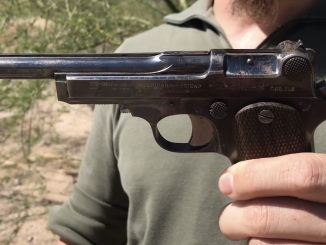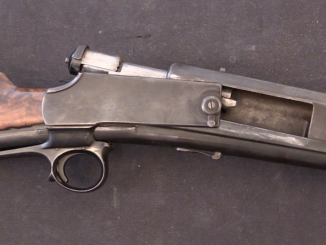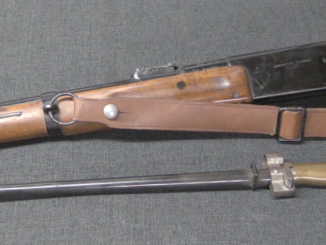RIA’s catalog page on this mortar
A new very light and portable mortar to replace the V-B rifle grenade was one of the facets of the French plan for rearmament and modernization after World War Two. The concept for the weapons that would become the L.Gr. Mle 37 was first requested in 1924 – but like so almost all the other parts of that arms program, it was crippled by delays through the 1920s and 1930s. Only in the late 1930s when was was looking imminent did the program finally move forward.
The design, created by Captain Nahan of the Chatellerault arsenal, was adopted in 1937 and a whopping 21,950 were ordered in January of 1938 – and the order was quickly revised up to 50,000. However, only 2900 had been produced by the time of the armistice in June 1940. Production resumed in 1944, and the launcher did see use in Indochina. In addition, its 50mm grenade was the basis for the postwar French rifle grenades, as used on the MAS-36 LG 48, the MAS-44, and MAS-49 rifles. As fired form the mortar, the projectile weighed about one pound (0.4kg) and had a range of 80 to 460 meters, with an effective rate of fire up to 20 rounds per minute.
If you enjoy Forgotten Weapons, check out its sister channel, InRangeTV! http://www.youtube.com/InRangeTVShow




The idea of gas bleeding to reach desired range is interesting and logical. To achieve this I presume, gas compartment had to be created by appropriate seal ring. It would be nice to see a grenade as well and shoot it, if possible.
On general subject of implementation of new and quite technically advanced weapon infantry systems in French military on outset of WWII(and the same seem to applied far aviation, such as new fighters MS406), it was woefully delayed. I recall reading memories of a volunteer in French military in early 1940. According to him, they still used obsolete pattern of rifles (not specifically mentioned); probably Lebel or Berthier wile excellent MAS36 was not available to all troops. Also, logistics were in near catastrophic conditions.
“idea of gas bleeding to reach desired range is interesting and logical. To achieve this I presume, gas compartment had to be created by appropriate seal ring”
Japanese in their TYPE 89 (known as KNEE MORTAR to U.S. forces) used different solution to allow muzzle velocity adjustment, see description here:
http://www.chinaww2.com/2014/06/13/japanese-knee-mortar/
“(…)the projectile weighed about(…)0.4kg(…)and had a range of 80 to 460 meters(…)”
This mass is suspiciously low for 50 mm caliber mortar of that era.
For comparison:
German Granatwerfer 36 fire 0.9 kg shell (5 cm caliber)
British ordnance SBML two-inch mortar fire 0.96 kg shell (51 mm caliber)
Soviet mortars fire 0.85 kg shell (50 mm caliber)
The French Army had lots of budget cuts (no thanks to the Great Depression). I suppose they used substitute materials from time to time. Either that or Ian has picked up a messed-up document doctored for misinformation usage.
I found cross-section of projectile for that weapon, see post from Mar 18 Avr 2017, 18:42 here: http://www.tircollection.com/t33216-un-mini-mortier
it is quite short and if I understand correctly fins were made from aluminum and explosive filling is said to be either 70 g NX, 70 g SC, 57 g tolite (is that French name for TNT?). /For comparison German 5 cm Granatwerfer shell contained 115 g of TNT/ Does anybody know why in France they decided to use aluminum for fins?
“50mm grenade was the basis for the postwar French rifle grenades, as used on the MAS-36 LG 48, the MAS-44, and MAS-49 rifles.”
Is that rifle grenade Grenade à fusil antipersonnel de 50 mm Mle 1948 as shown and described here: http://titus2h.e-monsite.com/pages/apres-guerre/39-les-grenades-a-fusil-d-apres-guerre.html
?
If I understand correctly, weight is stated as 485 g including 75 g explosive: explosif NX and tolite earlier mentioned, SC is not mentioned, however schneidérite (anybody known U.S. name for that thing?) is mentioned.
Why SC was only used in mortar shell, schneidérite only in rifle grenade and explosif NX and tolite in both?
Rifle grenade apparently has always 75 g of explosive, while mortar shell has either 75 g or 57 g depending on explosive used. Why?
Had Grenade à fusil antipersonnel de 50 mm Mle 1948 aluminum fins also?
Now I found that site has also entry for ammunition for this 50 mm mortar, which is named: Grenade explosive de 50 mm F.A. Mle 1939 (Grenade Nahan)
http://titus2h.e-monsite.com/pages/entre-deux-guerres/27-grenades-a-fusil-de-l-entre-guerre.html
Which give mass as 470 g, and filling as either 73 g d’explosif NX either 55 g de tolite. No SC is mentioned at all.
a search in google scholar describes schneiderite (which is thus the english for schneidérite) as a mix of Ammonium nitrate (90%) Nitronaphthalene (10%). (source : Lecture demonstrations of incendiaries. II
M Antelman – Journal of Chemical Education, 1955 – ACS Publications) Sadly i can’t link an entire text since those publications can’t be freely accessed.
Hope it helped a little.
As seen on this channel, the British rifle grenade launching cup, starting in World War I, was also a gas-bleed system; the rifle was always held at a 45-degree angle and the aperture in the cup adjusted for range.
from photos i always thought it was way bigger, than it actually is. in the hands of ian it is almost the size of a pioneer shovel!
Infantry mortars are usually not very big. They’re supposed to be compact and man-portable. If you noticed, the barrel is pretty thin. In any case, I’m pretty sure the developments in mortars and artillery in general greatly contributed to the success of the French Alpine Line against the invading Italian Army. Even the Germans admitted that they would NOT attack the Alpine Line, as its fortifications were in tank-unfriendly terrain and the stormy weather of the French Alps tended not to favor airstrikes at all (lots of snow storms happened over there in the middle of June, 1940).
When I was a kid, I had a plastic “Marine Raider” toy mortar (spring operated) that was bigger than this!
Part way threw video: Ian is definitely buying this.
Near end of video: ‘I own one of these but it’s deactivated’
NX= Mix of Ammonium Nitrate and Trinitroxylene
Schneiderite: mix of Ammonium Nitrate and some Nitrocompounds
Tolite = TNT
Thanks for explanation. Light weight of projectile raise question of performance (blast radius). ~50 mm mortar was not generally considered very effective and in this case additionally relatively light projectile.
Dear Ian:
The Turks at the “K. Kale” factory, just east of Ankera, made K-98 mausers in 8×57 with a barrel that is much heavier than the Berlin made Mausers. Can you get one and do a video on it ,please? It has a few other differences and some offer some real difficulty to disassembly. There are quite a few of these rifles around and the design dates from 1938 when the Turks began updating the older WW1 K-98 they bought from Germany at the time , but also began building their own entirely made at the Kirikail Arms factory. It would make a good video for Forgotten Weapons.
The power of the shell is about on par with the 45mm shell used by the odd little Brixia Model 35, a breech-loading mortar on a tripod (with a seat!). I think the British 2″ mortar was similar in weight to the French mortar but used a heavier shell (closer to the German 5cm).
I would like to say something before everyone is having fun with overdevelopment. At the time when the grenade launcher was developed, the majority of the German infantry generals assumed that the trench warfare and posture warfare of the First World War would be repeated. The grenade launcher is so heavy and unwieldy to transport because he was not even meant to change position often. The grenade launcher is equipped to fire from a fixed position another fixed position of the enemy (trenches, MG positions, manholes) with high precision and off. He was probably much more accomplished than his French counterpart, which was lighter and missed smaller grenades with less explosive power. And that, although the French army also expected a long positional war and therefore built the Maginot Line. It is pointless to tell the story of its end, because the mechanization of World War II actually turned it into a war of aggression, and the grenade launcher proved too heavy for it. For this he was originally not built.